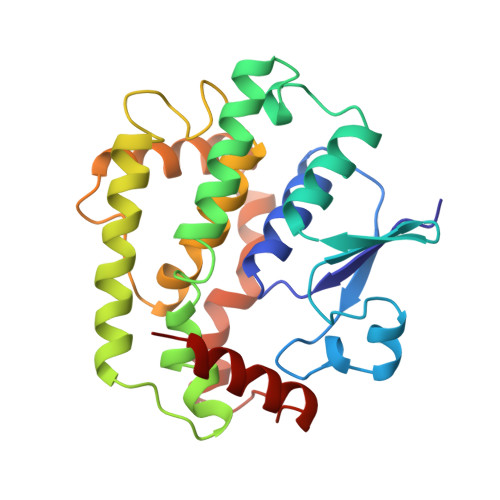Human theta class glutathione transferase: the crystal structure reveals a sulfate-binding pocket within a buried active site.
Rossjohn, J., McKinstry, W.J., Oakley, A.J., Verger, D., Flanagan, J., Chelvanayagam, G., Tan, K.L., Board, P.G., Parker, M.W.(1998) Structure 6: 309-322
- PubMed: 9551553
- DOI: https://doi.org/10.1016/s0969-2126(98)00034-3
- Primary Citation of Related Structures:
1LJR, 2LJR, 3LJR - PubMed Abstract:
Glutathione S-transferases (GSTs) comprise a multifunctional group of enzymes that play a critical role in the cellular detoxification process. These enzymes reduce the reactivity of toxic compounds by catalyzing their conjugation with glutathione. As a result of their role in detoxification, GSTs have been implicated in the development of cellular resistance to antibiotics, herbicides and clinical drugs and their study is therefore of much interest. In mammals, the cytosolic GSTs can be divided into five distinct classes termed alpha, mu, pi, sigma and theta. The human theta class GST, hGST T2-2, possesses several distinctive features compared to GSTs of other classes, including a long C-terminal extension and a specific sulfatase activity. It was hoped that the determination of the structure of hGST T2-2 may help us to understand more about this unusual class of enzymes. Here we present the crystal structures of hGST T2-2 in the apo form and in complex with the substrates glutathione and 1-menaphthyl sulfate. The enzyme adopts the canonical GST fold with a 40-residue C-terminal extension comprising two helices connected by a long loop. The extension completely buries the substrate-binding pocket and occludes most of the glutathione-binding site. The enzyme has a purpose-built novel sulfate-binding site. The crystals were shown to be catalytically active: soaks with 1-menaphthyl sulfate result in the production of the glutathione conjugate and cleavage of the sulfate group. hGST T2-2 shares less than 15% sequence identity with other GST classes, yet adopts a similar three-dimensional fold. The C-terminal extension that blocks the active site is not disordered in either the apo or complexed forms of the enzyme, but nevertheless catalysis occurs in the crystalline state. A narrow tunnel leading from the active site to the surface may provide a pathway for the entry of substrates and the release of products. The results suggest a molecular basis for the unique sulfatase activity of this GST.
Organizational Affiliation:
Ian Potter Foundation Protein Crystallography Laboratory, St. Vincent's Institute of Medical Research, Fitzroy, Victoria, Australia.















